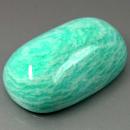|
|
||||||||||||||||
|
||||||||||||||||
|
||||||
|
|
|
|
Microcline
|
|
| | |
| Discovered in 1830; IMA status: Valid (pre-IMA; Grandfathered) | ||
|
| ||
|
Chemistry |
|
|
| |
|
KAlSi3O8 | |
|
|
Potassium Aluminum Silicate |
|
Molecular Weight: |
278.33 gm |
|
Composition: |
Potassium |
14.05 % |
K |
16.92 % |
K2O |
|
|
Aluminum |
9.69 % |
Al |
18.32 % |
Al2O3 |
|
|
Silicon |
30.27 % |
Si |
64.76 % |
SiO2 |
|
|
Oxygen |
45.99 % |
O |
|
|
|
|
|
100.00 % |
|
100.00 % |
= TOTAL OXIDE |
|
|
|
||||
|
Classification |
|
|
| |
|
Silicates (Germanates) | |
|
8/J.06-30 | |
|
|
9 : SILICATES (Germanates)
|
|
Related to: |
Feldspar Group. Dimorph of Orthoclase. |
|
Members of Group: |
Feldspar Group: Albite, Andesine, Anorthite, Anorthoclase, Banalsite, Buddingtonite, Bytownite, Celsian, Dmisteinbergite, Hyalophane, Labradorite, Oligoclase, Orthoclase, Paracelsian, Reedmergnerite, Sanidine, Slawsonite, Stronalsite, Svyatoslavite |
|
Varieties: |
Amazonite, Chesterlite, Ferruginous Microcline |
|
Synonyms: |
Microline |
|
|
|
|
Crystal Data |
|
|
|
|
|
Crystals are prismatic and elongated, perhaps the largest of any species, to 50 m and 13,500 tons. Cleavable to granular, massive. |
|
|
Carlsbad, Baveno, and Manebach laws very common; polysynthetic twinning on the Albite and Pericline laws give an orthogonal grid pattern. |
|
|
|
|
|
Physical Properties |
|
|
|
|
|
Perfect on {001} and {010}, intersecting at ~90º; partings on {100}, {110}, {110}, and {201}. |
|
|
Uneven/Irregular |
|
|
Brittle |
|
|
6.0 - 6.5 |
|
|
2.54 - 2.57 (g/cm3) |
|
|
Possibly Fluorescent, cherry red under SW UV |
|
|
Barely Detectable; GRapi = 200.97 (Gamma Ray American Petroleum Institute Units) |
|
|
|
|
|
Optical Properties |
|
|
|
|
|
Pale green to dark green, aqua green, bluish green |
|
|
Translucent to Opaque |
|
|
Vitreous, Pearly on cleavages |
|
|
1.514 - 1.539 Biaxial ( - ) |
|
|
0.007 |
|
|
Relatively weak; r > v |
|
|
None |
|
|
|
|
|
Occurances |
|
|
|
|
|
Geological Setting: |
Common in plutonic felsic rocks, as granites, granite pegmatites, syenites; in metamorphic rocks of the greenschist and amphibolite facies; in hydrothermal veins. A detrital component in sedimentary rocks and as authigenic overgrowths. |
|
Common Associations: |
Quartz, Sodic Plagioclase, Muscovite, Biotite, "Hornblende" |
|
Common Impurities: |
Fe, Ca, Na, Li, Cs, Rb, H2O, Pb |
|
Co-Type Localities: |
•
Arendal, Aust-Agder, Norway
|
|
Year Discovered: |
1830 |
|
View mineral photos: | |
|
|
|
|
More Information |
|
|
|
|
|
| |
|
|
|
|
Microcline was named in 1830 by Johann Friedrich August Breithaupt from the Greek words μικρός (mikron) meaning little and κλινειν (klinein) meaning to incline, in allusion to the slight deviation of the cleavage planes from 90 degrees. Microcline is found as three varieties; Amazonite, Chesterlite and Ferruginous Microcline. Another "type" of Microcline is Perthite. Amazonite is, by far, the most well known and popular variety of Microcline and is readily available as mineral specimens and gemstones. Amazonite is the pale green to bluish green variety of Microcline. Some of the most beautiful Amazonite crystals come from the Pike's Peak and Crystal Peak areas of Colorado, USA. Amazonite is almost always opaque and makes for beautifully colored cabochons. However, a recent find in Mogok, Myanmar (Burma) has produced a small number of extremely rare transparent crystals that have been faceted into gems. Another recent find in Vietnam has produced vivid green crystals that have been faceted into beautiful gems of amazing clarity and color. Chesterlite is a very minor variety of Microcline that is white to pale tan and found only at the Poorhouse Quarry, West Bradford, Chester County, Pennsylvania, USA. Ferruginous Microcline is a rare iron (Fe) rich variety of Microcline that is found in shades of red, red-brown and pinkish-red. Mindat.org does not list any localities for Ferruginous Mincrocline. Perthite is not actually a variety of Microcline but an intergrowth of Albite or Oligoclase within a Microcline host, occasionally also within an Orthoclase host. The intergrowths are visible as white ribbons of Albite running through a tan to pale pink Microcline host. Perthite was originally described from near Perth, Lanark County, Ontario, Canada. Perthite is also found at a few localities in Norway and the USA. Microcline
distribution: a widespread mineral. Notable occurrences
include: at Fredriksvärn, Arendal, and Larvik,
Norway. In the Ilmen Mountains, Ural Mountains, and
on the Kola Peninsula, Russia. At St. Gotthard, Ticino,
Switzerland. On Mt. Greiner, Zillertal, Tirol, Austria.
At Baveno, Piedmont, Italy. In the USA, at Amelia, Amelia
County, Virginia; Haddam, Middlesex County, Connecticut;
and Magnet Cove, Hot Spring County, Arkansas. In Colorado,
in the Pikes Peak area, El Paso County, Crystal Peak,
Teller County, with large crystals from the Devil's
Hole beryl mine, Fremont County; in the Black Hills,
Pennington and Custer Counties., South Dakota. At Bancroft,
Ontario, Canada. From Klein Spitzkopje, Namibia. In
Brazil, from Minas Gerais, at Fazenda do Bananal, Salinas,
Urucum, and Capelinha. At Ambositra, Madagascar. From
Kimpusan, Yamanshi Prefecture, and Tanakamiyama, Otsu,
Shiga Prefecture, Japan. At Broken Hill, New South Wales,
Australia. |
|
|
Please
visit the Amazonite
information page for Microcline gems for sale. |
